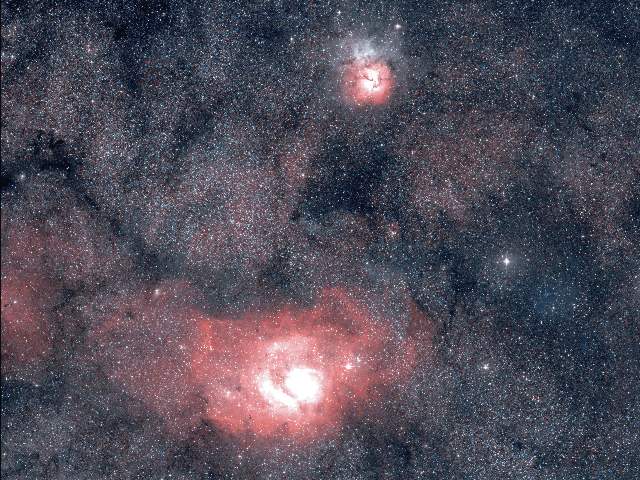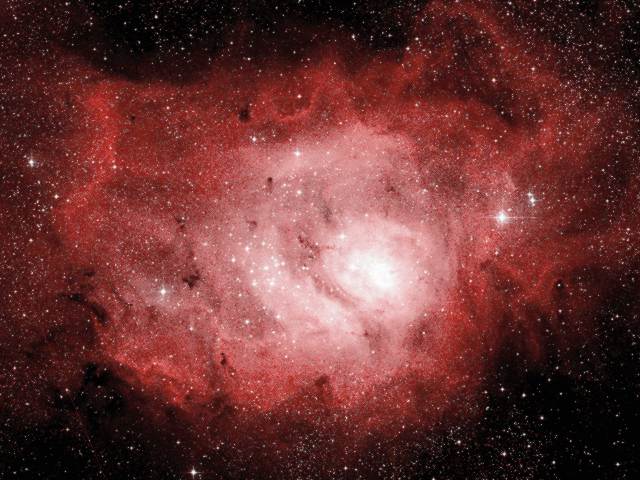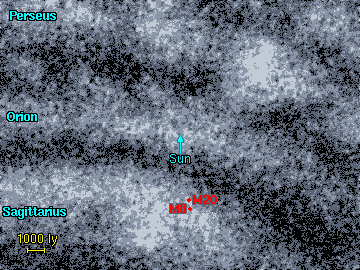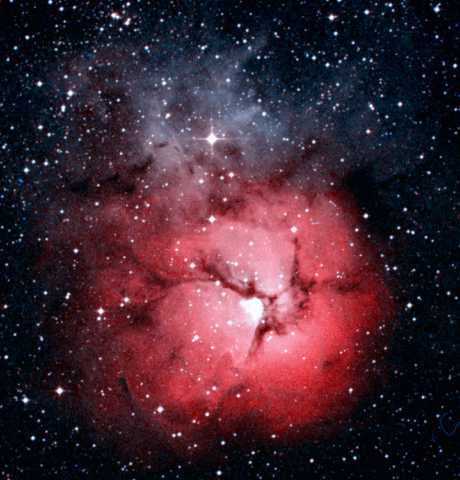
M8 and M20. Image size: 2.8°x2.1°. DSS image. © AAO/ROE
The Lagoon and Trifid nebulae are two very famous nebulae in Sagittarius, and both nebulae can be glimpsed with the naked eye (from a dark site), and they are easy to see with binoculars. This picture shows these two nebulae against the background of the dense star fields of the Sagittarius Arm of the Galaxy. The Lagoon nebula (M8) is the larger (and brighter) nebula to the south of the smaller Trifid nebula (M20).

This is a list of the nebulae in this region. The only major nebulae here are the Trifid and Lagoon nebulae. All of the other nebulae in this list are bright nebulous patches associated with the Lagoon nebula. The distance to the Trifid nebula is very uncertain. It is associated with a star cluster, but distance estimates to this star cluster vary enormously from 2700 to over 5200 light years. A distance of about 4000 light years is probably a reasonable distance for both the nebula and the star cluster.
1 2 3 4 5 6 7 8
Catalogue Equatorial Galactic Size Type Distance Size Other Names
Number Coordinates Coordinates (arcmins) (ly) (ly)
RA (2000) Dec l° b°
---------------------------------------------------------------------------------------
NGC 6514 18 02.3 -23 02 7.0 -0.2 20' RE 4000 25 M20, Trifid nebula
NGC 6523 18 03.8 -24 23 6.0 -1.2 45' E 4350 55 M8, Lagoon nebula
NGC 6526 18 04.1 -24 26 6.0 -1.3 40' E 4350 50 NGC 6533
IC 1271 18 05.2 -24 25 6.1 -1.5 20' E 4350 25
IC 4678 18 06.6 -23 57 6.7 -1.6 30' E 4350 35
IC 4681 18 09.1 -23 26 7.4 -1.8 3' E 4350 4 IC 4684
IC 1274 18 09.8 -23 39 7.3 -2.0 6' E 4350 8 IC 1275
NGC 6559 18 10.0 -24 07 6.9 -2.3 8' E 4350 10
|
Column 1: The standard catalogue name for the nebula. Column 2: Right Ascension and Declination for epoch 2000. Column 3: Galactic Longitude (l) and Latitude (b). Column 4: Angular size of the nebula in arcminutes. Column 5: Nebula type: E = emission, R = reflection. Column 6: Approximate distance to the nebula. Column 7: Approximate size of the nebula in light years. Column 8: Alternative name of the nebula.
This is a list of the star clusters which are probably nearest to these two nebulae. NGC 6514 is the star cluster associated with the Trifid nebula, and NGC 6530 is the star cluster associated with the Lagoon nebula. Recent star cluster catalogues put NGC 6514 at a distance of only about 2700 light years. However if it was at this distance, then the main sequence stars in the cluster should be about 1 magnitude brighter than those in NGC 6530 - I can find no evidence that this is true and a distance of 4000 to 5000 light years may be more reasonable (although the presence of dust in this region makes it difficult to be certain).
1 2 3 4 5 6 7
Catalogue Equatorial Galactic Size Distance Age Other Names
Name Coordinates Coordinates (arcmins) (ly) (million
RA (2000) Dec l° b° years)
---------------------------------------------------------------------------------
NGC 6469 17 53.3 -22 17 6.6 +2.0 7' ? ?
NGC 6506 17 59.9 -24 41 5.3 -0.6 5' ? ? Ruprecht 138
Trumpler 31 17 59.9 -28 10 2.2 -2.3 5' 3200 740
Bochum 14 18 02.0 -23 41 6.4 -0.5 2' 1900 10
NGC 6514 18 02.8 -22 58 7.1 -0.3 28' 2650 23 M20
NGC 6520 18 03.5 -27 53 2.9 -2.8 5' 5150 53
NGC 6531 18 04.3 -22 29 7.7 -0.4 14' 3950 12 M21
NGC 6530 18 04.6 -24 22 6.1 -1.3 14' 4350 7
NGC 6546 18 07.4 -23 18 7.3 -1.4 14' 3050 71
IC 4685 18 09.3 -23 59 7.0 -2.2 39' ? ? Collinder 367
NGC 6568 18 12.8 -21 36 9.4 -1.7 12' ? ?
NGC 6583 18 15.9 -22 08 9.3 -2.5 5' ? ?
|
Column 1: The standard catalogue name for the cluster.
Column 2: Right Ascension and Declination for epoch 2000.
Column 3: Galactic Longitude (l) and Latitude (b).
Column 4: Angular size of the cluster in arcminutes.
Column 5: Distance to the cluster.
Column 6: Approximate age of the cluster in millions of years.
Column 7: Alternative name of the cluster.
References: Dias W, Alessi B, Moitinho A, Lépine J, (2002). New catalogue of optically
visible open clusters and candidates. Astron and Astrophys, 389, 871.
Below is a map of these two nebulae. The Lagoon nebula (M8) is spread across about two degrees of the sky (about 150 light years). The nearby Trifid nebula (M20) is much smaller and it is also known to be part of a separate molecular cloud.

This is a picture of the Lagoon nebula. This is the bright central region of the Lagoon nebula. If the nebula has a distance of 4300 light years then this photograph has a width of about 75 light years. The Lagoon nebula glows mainly because of the presence of two massive naked-eye stars in the nebula (7 and 9 Sagittarii) which are responsible for ionising the gas.


|
The Lagoon and Trifid nebulae are both in the Sagittarius Arm of the Galaxy. The precise distance to the Trifid nebula is rather uncertain, but it is definitely within the Sagittarius Arm, and it is probably fairly close to the Lagoon nebula. |
| The Trifid nebula is a young and compact nebula with a diameter of about 25 light years (about 15000 times the diameter of our solar system). Dark dust lanes in the nebula appear to split the nebula into three parts. The bottom half of this nebula is a bright emission nebula with a distincive pink colour, but the top part of the nebula is reflection nebula with a characteristic blue colour. |  M20. Image size: 0.34°x0.35°. DSS image. |